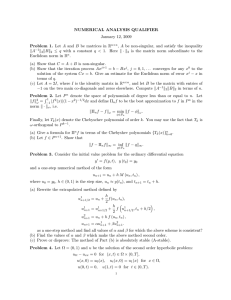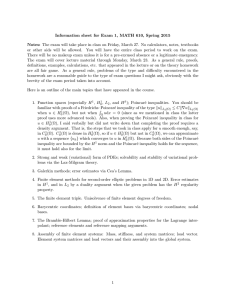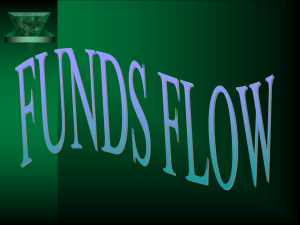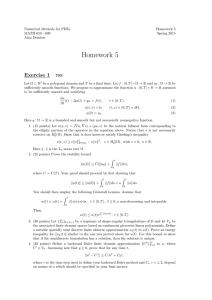QUASILINEARIZATION FURTHER GENERALIZED GENERALIZATION OF
advertisement
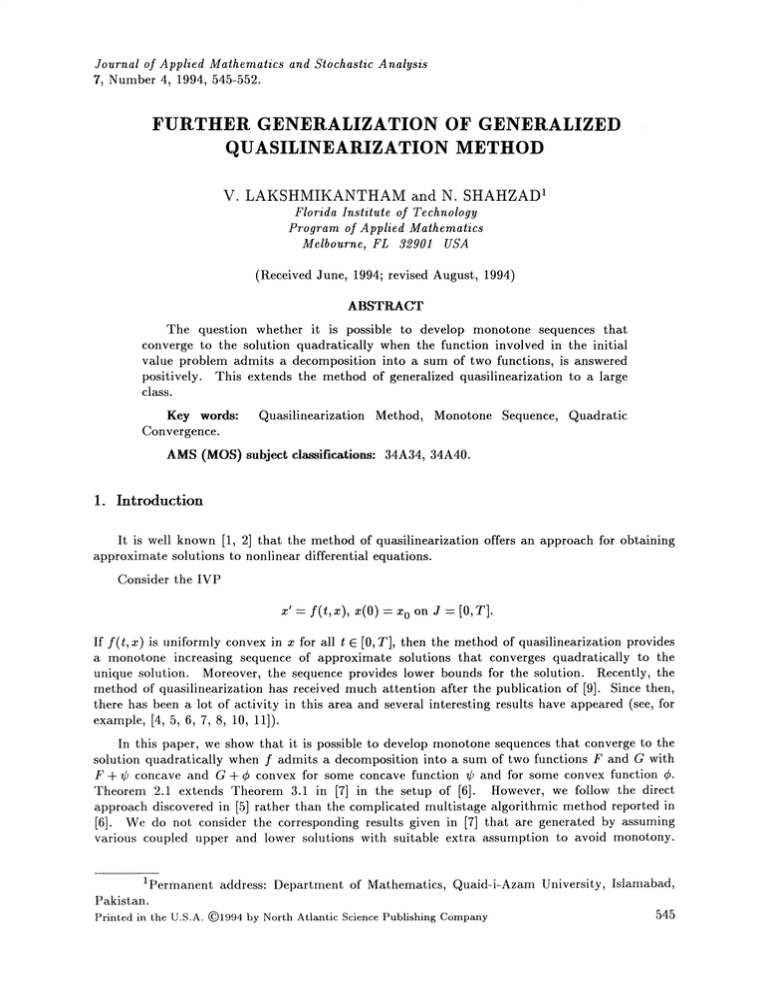
Journal of Applied Mathematics and Stochastic Analysis
7, Number 4, 1994, 545-552.
FURTHER GENERALIZATION OF GENERALIZED
QUASILINEARIZATION METHOD
V. LAKSHMIKANTHAM and N. SHAHZAD 1
Florida Institute
of Technology
Program of Applied Mathematics
Melbourne, FL 32901 USA
(Received June, 1994; revised August, 1994)
ABSTRACT
The question whether it is possible to develop monotone sequences that
converge to the solution quadratically when the function involved in the initial
value problem admits a decomposition into a sum of two functions, is answered
positively. This extends the method of generalized quasilinearization to a large
class.
Key words:
Convergence.
Quasilinearization Method, Monotone Sequence, Quadratic
AMS (MOS) subject classifications: 34A34, 34A40.
1. Introduction
It is well known [1, 2] that the method of quasilinearization offers an approach for obtaining
approximate solutions to nonlinear differential equations.
Consider the IVP
x’
f(t,x), x(O)
x o on
J
[0, T].
is uniformly convex in x for all t E [0, T], then the method of quasilinearization provides
increasing sequence of approximate solutions that converges quadratically to the
unique solution. Moreover, the sequence provides lower bounds for the solution. Recently, the
method of quasilinearization has received much attention after the publication of [9]. Since then,
there has been a lot of activity in this area and several interesting results have appeared (see, for
If
f(t,x)
a monotone
example,
[4, 5, 6, 7, 8, 10, 11]).
.
In this paper, we show that it is possible to develop monotone sequences that converge to the
solution quadratically when f admits a decomposition into a sum of two functions F and G with
F + concave and G + convex for some concave function and for some convex function
Theorem 2.1 extends Theorem 3.1 in [7] in the setup of [6]. However, we follow the direct
approach discovered in [5] rather than the complicated multistage algorithmic method reported in
[6]. We do not consider the corresponding results given in [7] that are generated by assuming
various coupled upper and lower solutions with suitable extra assumption to avoid monotony.
1permanent address: Department of Mathematics, Quaid-i-Azam University, Islamabad,
Pakistan.
Printed in the U.S.A.
@1994 by
North Atlantic Science Publishing Company
545
V. LAKSHMIKANTHAM and N. SHAHZAD
546
Clearly, based on our results and those of
possible combinations.
2.
[7],
it is not difficult to construct the proofs of other
Main Result
Consider the initial value problem
x’
where
f E C[J x R, N]. Let
f(t,x), x(O)
a0, 30 E
f
(IVP)
C’[J, R] such
xo,
that a 0
[O,T]
J
t
(2.1)
_</0 on J. We define a set
{(t,x):ao(t <_ x <_ o(t),t
Theorem 2.1: Assume that
ao, o
C’[J,] such that a’o <_ f(t, ao) ’o >- f(t,o) and a o <_/o on J;
f C[,], f admits a decomposition f F +G where Fx, Gx, F z x, Gxx exist and
are continuous satisfying Fxx(t x) + Cxx(t, x) <_ 0 and Gxx(t x) + Cxx(t, x) >_ 0 on
f], where
C[f,], Cx(t, x), Cx(t, x), Cxx(t, x), Cxx(t, x) exist, are continuous
and Cxx(t,x) < O, Cxx(t,x) > 0 on f.
Then there exist monotone sequences {an(t)} {n(t)} which converge uniformly to the unique
solution of (2.1) and the convergence is quadratic.
Proof: In view of (A2) we see that
A1)
A)
,
F(t,y) <_ H(t,x)- Hx(t,x)(x- y)- (t, y)
(2.2)
G(t,x) >_ M(t,y) + Mx(t,y)(x- y)- (t, x)
and
for x >_ y, x,y G f, where H(t,x)
clear that whenever ao(t _< x 2 _< x
F(t,x) + (t,x)
_</o(t)
and
G(t,x) + (t,x). Also,
M(t,x)
f(t, xl) f(t, x2) <_ L(x I x2) for
some
L
)
it is
(2.3)
0.
Let al, fll be the solutions of linear IVPs
c
i f(t,cO)+ [Mx(t, a 0) + Hx(t, O) Cx(t, Co)- Cx(t,/3o)](c1 -ao), O1(0
X0,
(2.4)
X0’
(2.5)
and
/31
where
f(t,/3o) + [Mx(t, ao) + Hx(t, 13o)- Cx(t, ao)-x(t, t3o)](131 /o), /1(0)
ao(0) _< x o _</3o(0).
We shall prove that
0
a
o<_a 1 onJ.
To do this, let p-a o-casothat p(0)_<0. Then
1
<_ f(t, ao) If(t, ao) + {Mx(t, ao) + Hx(t, o) Cx( t, ao) Cx( t,/0)}(Ctl Ct0)]
[M x(t, ao) + H x(t, 0)
x(t, c0)
x(t, 0)]P"
Further Generalization
Since
p(0) _< 0,
we
get
Oo(t _< Ctl(t
of Generalized Quasilinearization
on
J. Next
we let p-
ct I
Now
Method
--flO and
note that p(O)
547
_< O.
<_ f(t, Co) + [Mz(t, Co) + Hx(t, o) (t, Co) Cx(t,/0)](Ctl Ct0) f(t, fl0)"
But since/3 o > Co, using (2.2) and
(A2)
we have
r(t, o) < H(t, flo) H(t, flo)(flo o) (t, o)
and
G(t,/3o) >_ M(t, o) + M(t, Oo)(fl o Oo) (t, flo),
or
F(t, Co) <_ F(t,/3o) Hx(t, flo)(flo Co) + [O(t,/30) (t, Cto)
and
G(t, o) >- G(t, Co) + Mx(t, Co)(fl o Co) [(t, flo) (t, Oo) ].
Now, by using the
theorem,
mean value
(t, flo) (t, o)
(t, )(flo o)
6(t, #o) 6(t, o)
6(t, 6)(#o o),
and
where c o
that
<
,
5 </3 o. Because
and
Cx(t,x)
is decreasing in x and
Cz(t,x)
is increasing in x, it follows
(t, flo) (t, o) -< (t, o)(o o)
(t, o) (t, o) -< (t, flo)(flo o).
Thus we get
F(t, Co) <_ F(t,/30) [Hx(t ,/30) (t, ao)](fl o Oo)
and
_
G(t, /30) >_ G(t, Co) + [Mx(t, Co) Cx(t,/30)](/30 Co)
which in turn yields
P’ < [Mx(t, Co) + Hx(t, o) Cx( t, Co) Cx( t,/o)]P"
Consequently, p(t) <_ 0 on J proving
c
/0 on Y.
As
a
result,
we have
s0(t
on
__
V. LAKSHMIKANTHAM and N. SHAHZAD
548
Similarly, we can show that
so that it follows
Sl(t
/0(t) on J.
ao(t <_/31(t _< flo(t)
on
J. We need to prove that
al(t _</31(t
J
so(t _< Sl(t _< ill(t) <_ flo(t) on J.
Since s 0
< S1
s’
(2.6)
< fl0, using (2.2) and (2.4), we see that
f(t, So) + [Mx(t So) + Hx(t,/30) (t, So) Cx(t, #0)](Sl S0)
[F(t, So) + Hx(t, 3o)(S
So) + [G(t, So) + Mx(t, S0)(S 1 S0)
-- - -
Cx(t, S0)(S 1 S0) Cx(t,/0)(Sl S0)
<_ iF(t, So) + Hx(t, s 1)(s I S0)
[G(t, So) M(t, S0)(S 1 S0)
Cx(t, S0)(Sl S0) Cx(t,/0)(Sl S0)
<_ [F(t, Sl) (t, Sl) (t, S0)
[a(t, Sl) (t, Sl) (t, S0)
Cx(t, S0)(S 1 S0) Cx(t,/0)(Sl S0)
<_ f(t, Sl) Cx(t, So)(S 1 s0) -t- Cx(t, flo)(sl So)
)x(t, So)(S 1 s0) Cx(t, flo)(sl So)
f(t, sl).
Here we have used the mean value theorem and the facts that
x and x(t,x) is increasing in x.
Hz(t,x), x(t,x)
are
decreasing in
> f(t,31) and therefore by Theorem 1.1.1 [3], it follows that
(2.6) is valid.
k >1,
-< f(t, sk), ’k > f(t,k) and sk(t _< k(t) on J, we
Similarly, we can prove that /3]
on J which shows that
sl(t </31(t
Assume
now that for some
shall show that
Sk(t)
s
Sk + 1(t)
k -t- (t) flk (t)
on
J,
(2.7)
where s k + and/3 k + are the solutions of linear IVP’s
Sk +
f(t, sk) + [Mx(t sk) + Hx(t k) (t, sk) (t,/3k)](s k + 1 Sk)’
Sk + 1(0)
X0,
and
’k +
f(t, ) + [Mx(t, sk) + Hx(t, k) x( t, sk) Cx( t,/3k)](/3k + --/k)’
(2.8)
Further Generalization
of Generalized Quasilinearization
Method
549
(2.9)
Hence setting p- a k -a k + 1, it follows as before that
p’ <_ [Mx(t ak) + Hz(t, ilk) Cz( t, ak) z(t, flk)]P
on
J
and p(0)- 0 which again implies p(t)<_ 0 on J. On the other hand, letting p- c k+a-flk
yields as before p’ <_ [ix(t, ck) + Ux(t, ilk) x( t, ck) Cx( t, /)]P" This proves that p(t) <_ O,
since p(0) 0 and therefore we have c k _< c k +
k on J. In a similar manner, we can prove
that
--
-<
k
fl k -t-1
fl k on J.
flk --> ck +1 Ck’ we get
f(t, ak) + [Mx(t, ak) + Hz(t, k) z(t, Ck) Cx(t, flk)](Ck +
Now using (2.2), (2.8) and the fact
0 q_ 1
Ok)
[F(t, ak) + Hx(t, k)(ak + 1 Ck)] -+- [G(t, Ok) q- Mx(t, ak)(a k + 1 Ok)]
Cx( t’ Ok)(Ok q- --Ok)- Cx( t’ flk)(Ok + 1 --Ok)]
<- [F(t, ak) + Hx(t, ak + )(ak + 1 --Ok)] -{- [G(t’k) q- Mx(t, ak)(ak +
Ok)]
(t, Ok)(Oe k + --Ok)- Cx( t’ k)(Ok + --Ok)
[F(t’ok q- 1) q- (t’Ok q- 1)- (t’ Ok)] -+- [G(t’k q- 1) + (t’Ok q- 1)
)x( ;t’ Ok)(Ok + --Ok)- Cx( t’ k)(Ok + --Ok)
f(t,ok + 1).
Here we have used the mean value theorem and the facts that
x and Cx(t,x) is increasing in x.
’
I +1
Similar arguments yield k+l >f(t
+ 1(t) flk + 1(t) on J which proves (2.7).
we obtain
and hence Theorem 1.1 1
- - -----
-<
Hence
Hx(t,x), Cx(t,x)
are decreasing in
[3]
shows that
by induction
< OZn fin
f12 fl fl O on d.
00 OZl Ct2
Now using standard arguments, it is easy to show that the sequences {an(t)}, {fin(t)}
converge uniformly and monotonically to the unique solution x(t) of (2.1) on J. Finally, to prove
quadratic convergence, we consider
Pn + l( t)- x(t)
Note that Pn + 1(0)
0
n + l( t)-> O,
qn + l( t)-
n+l(t)-x(t) >_ O.
qn + 1(0)" We then have
p +l--X --Ctn+
f(t, x) If(t, an) + {Mx(t, an) + Hx(t’ n) Cx( t’ an) Cx( t’ fln)](cn +
_
_
550
V. LAKSHMIKANTHAM and N. SHAHZAD
{H(t,x)- H(t, an) } + {M(t,x)- M(t, an) } {(t, x)- (t, an) }
{(t, x) (t, an) } {Mx(t, an) + Hx(t, n) Cx( t’ an) Cx( t, n)}(an +
Hx(t, an)(x an) + Mx(t,x)(x
a n)
Cx(t,x)(x an)
{Mx(t an) + Hx(t, fin) Cx(t, an) Cx(t, fln)J(an + 1
X
-
an)]
an)
X
Hzz(t, )(a n n)(x an) + Mxx(t, 5)(x an) 2 Cxx(t, 7)(x a.) 2
+ Cxx(t, O)(n an)(x an) + {Mx(t, an) + Hx(t n) x(t, an) Cx(t, n)}Pn + 1
{xx(t, O) Hxx(t, ,)}Pn(qn + Pn) + {Mxx( t’ 5) Cxx(t, 7)}p2n
+ { M x(t, a n) + H x(t’ n)
{xx(t, O)- Hxx(t, )}Pn(qn + Pn) + {Mxx( t, 5) Cxx(t, 7)}p2n
-t- {ax(t, an)
wherea n<(,
Hence,
-
x(t, an) Cx(t, fin)} Pn +
Fx(t, n)}Pn -l- 1,
0<flnanda n<5,
we obtain
7<x.
Pn + 1 " (A + B + C)Pn(qn + Pn) + (A + C + D)p2n + (E + K)p n + 1
_< (A + B + C)(2P 2n + q2n) + (A + C + D)p2n + (E + K)p n + 1
Qp2n + Rq2n + S Pn + 1’
where on
I(t,x) < A, Ir(t,x) < B, I%x(t,x) < C, Ia(t,x) < D,
la(t,x) <, IF(t,x) <K, Q-3A+2B+aC+D, R-A+B+C
(2.10)
S-E+K.
and
Now Gronwall’s inequality implies
0
_< Pn + 1(t) <
which yield the desired result
--
maxlx(t)+1 (t) <
j
Similarly,
q’n+l
fln+l
x’
/ es(t
S)[Qpn(S)+2
Rq2u(s)]ds
on
g
0
Qmxlx(t)-.(t)12/-Rmxl3.(tD-x(t)l
2
f(t,n)+[Mx(t, an)+ Hx(t,n)-x(t, an)-x(t,n)](fln+ 1--n)--f(t, x)
Further Generalization
of Generalized Quasilinearization
Method
551
{H(t,n)- H(t,x)} + {M(t,n)- M(t,x)} + {(t, x)- (t, n) }
+ {(t, x) (t, fin)} + {Mz(t’ an) + Hx(t, n) Cx( t, an) Cx(t, fn)}(fln +
,)
<_ Hx(t,x)(n- x) + Mx(t, fln)( n x)- Cx(t,n)(n- X)--x(t,x)(n-- X)
+ {Mx(t’ an) + Hx(t,/n) Cx( t, an) Cx( t,/n)}(/n + 1
x
x
<_ {xx(t, O) Hxx(t t)}(n x) 2 + {Mxx(t, 5) Cxx(t, ")’)}(fin an)(n x)
+ {Gx(t, an) + Fx(t, n)}(n + 1 x)
{xx(t, O) Hxz(t t)}q2n + {Mxx(t, 5) Czx(t, 7)}(qn + Pn)qn
+ {Gx(t, an) + rx(t, tn)}qn + 1
,
< O < fln and
Hence, we obtain
where a n
an
< 5,
7
< x.
q’ + <_ (A + B + C)q2n(A + C + D)q,(q n + p,) + (E + K)q n + 1
<_ (A + B + C)q2n + (A + C + D)(2qn + Pn) + (E + K)q n +1
2
-Q*q2n+R pn+Sqn+
where the constants
A, B, C, D, E, K and S
are as in
(2.10)
and Q*-3A+B+3C+2D,
R*-A+C+D.
An application of Gronwall’s inequality yields
eS(t
O <_ qn + l( t)-<
S)
Q,q2n(s) + R pn(s) ds
on
J
0
and hence
maxj
/n + l(t)- x(t) _<
e-Q*rnx
.(t)- x(t)
+ R*maxj Ix(t)
This completes the proof of the theorem.
References
[3]
[4]
Bellman, R., Methods of Nonlinear Analysis Vol. II, Academic Press, New York, 1973.
Bellman, R. and Kalaba, R., Quasilinearization and Nonlinear Boundary Value Problems,
American Elsevier, New York, 1965.
Ladde, G.S., Lakshmikantham, V., and Vatsala, A.S., Monotone Iterative Techniques for
Nonlinear Differential Equations, Pitman, Boston, 1985.
Lakshmikantham, V., An extension of the method of quasilinearization, (to appear in
J.O.T.A.).
[5]
Lakshmikantham, V., Further improvement to generalized quasilinearization method, (to
appear in Nonlinear Analysis).
V. LAKSHMIKANTHAM and N. SHAHZAD
552
[6]
[7]
[8]
[9]
Lakshmikantham, V., Leela, S. and McRae, F.A., Improved generalized quasilinearization
method, (to appear in Nonlinear Analysis).
Lakshmikantham, V., Leela, S. and Sivasundaram, S., Extensions of the method of quasilinearization, (to appear in J.O.T.A.).
Lakshmikantham, V. and K6ksal, S., Another extension of the method of quasilinearization, (to appear in the Proceedings of DynamicSystems andApplications).
Lakshmikantham, V. and Malek, S., Generalized quasilinearization, Nonlinear World 1
(1994), 59-63.
[10]
[11]
Malek, S. and Vatsala, A.S., Method of generalized quasilinearization for second order
boundary value problem, Inequalities and Applications 3 (1994), (to appear).
McRae, F.A., Generalized quasilinearization of stochastic initial value problems, Stochastic
Analysis and Applications 13
(1994), (to appear).



